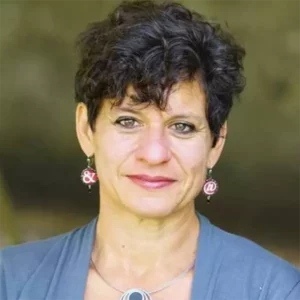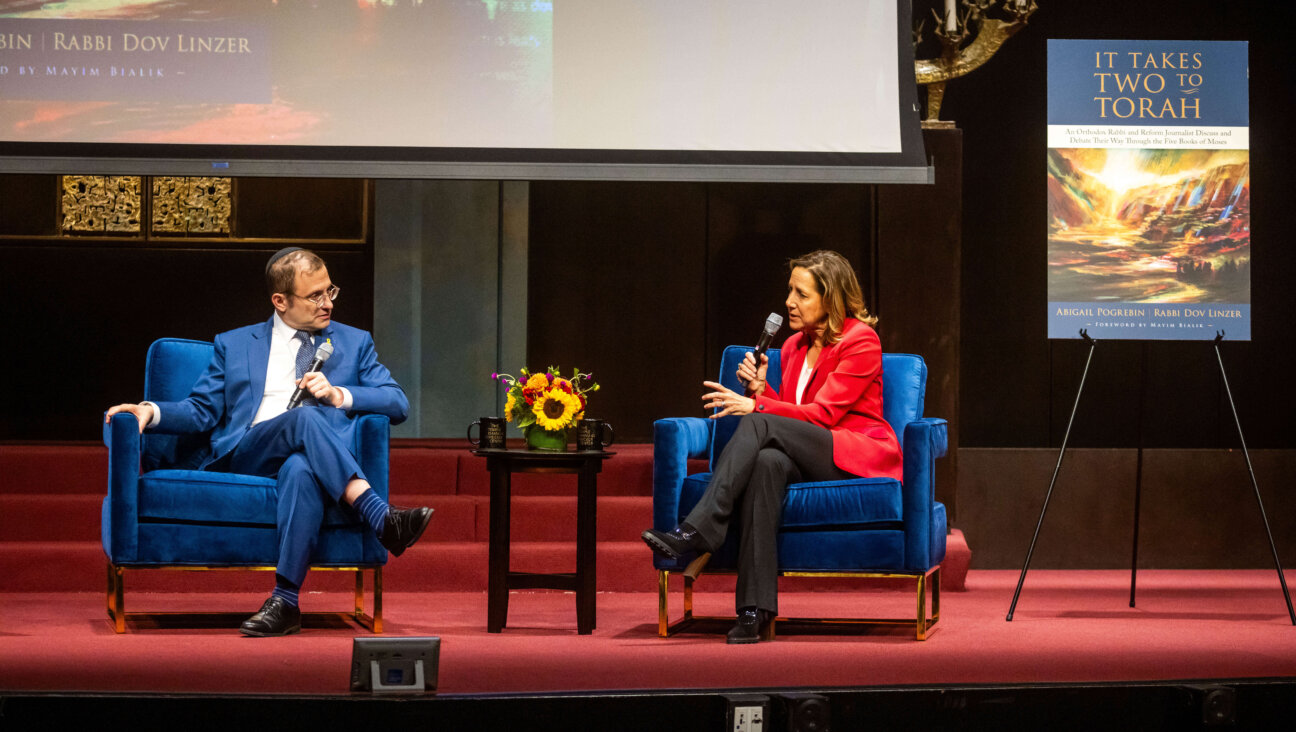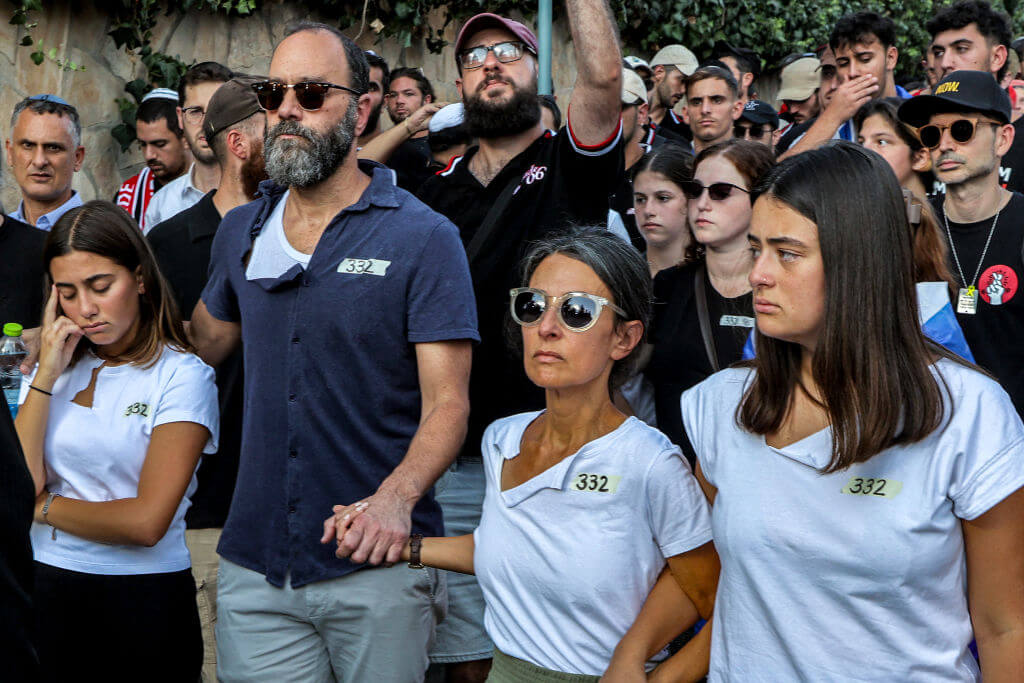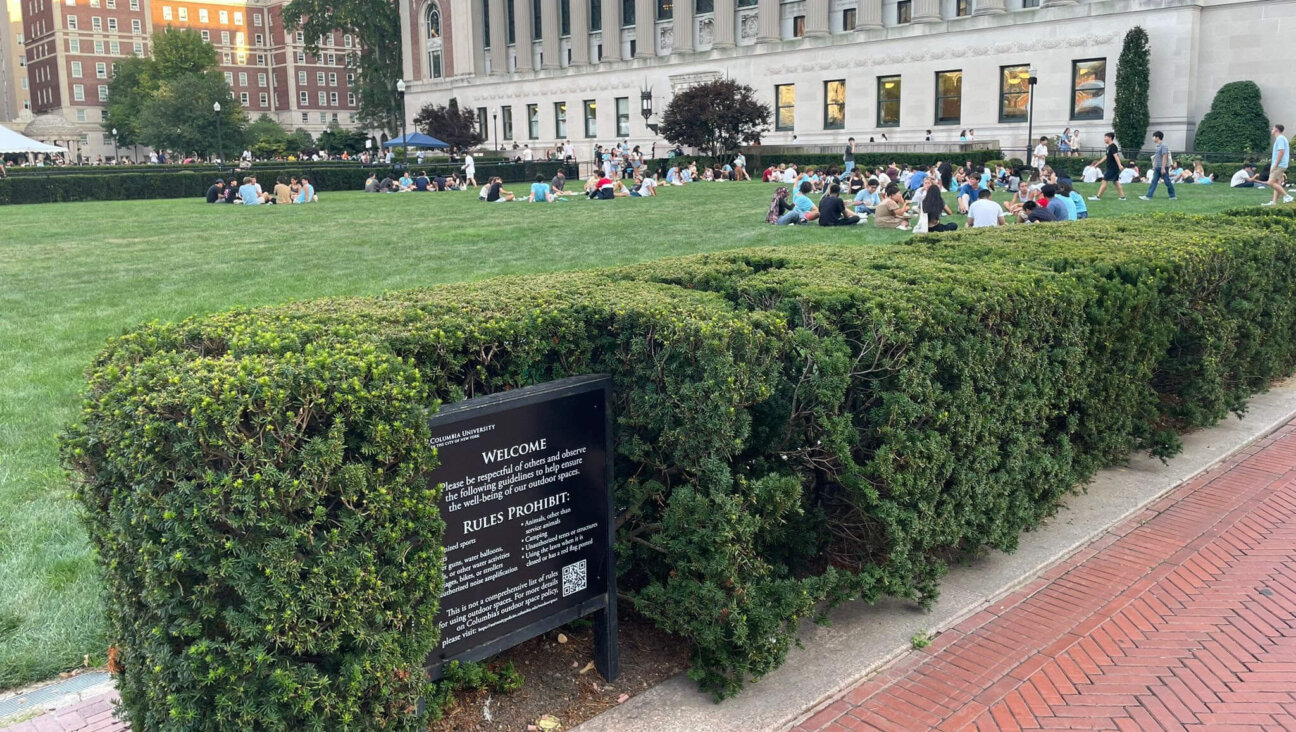What Israel should actually be doing inside Gaza’s al-Shifa Hospital
By helping to treat the wounded, the IDF has an opportunity to fulfill its aspiration of being the world’s most moral army.
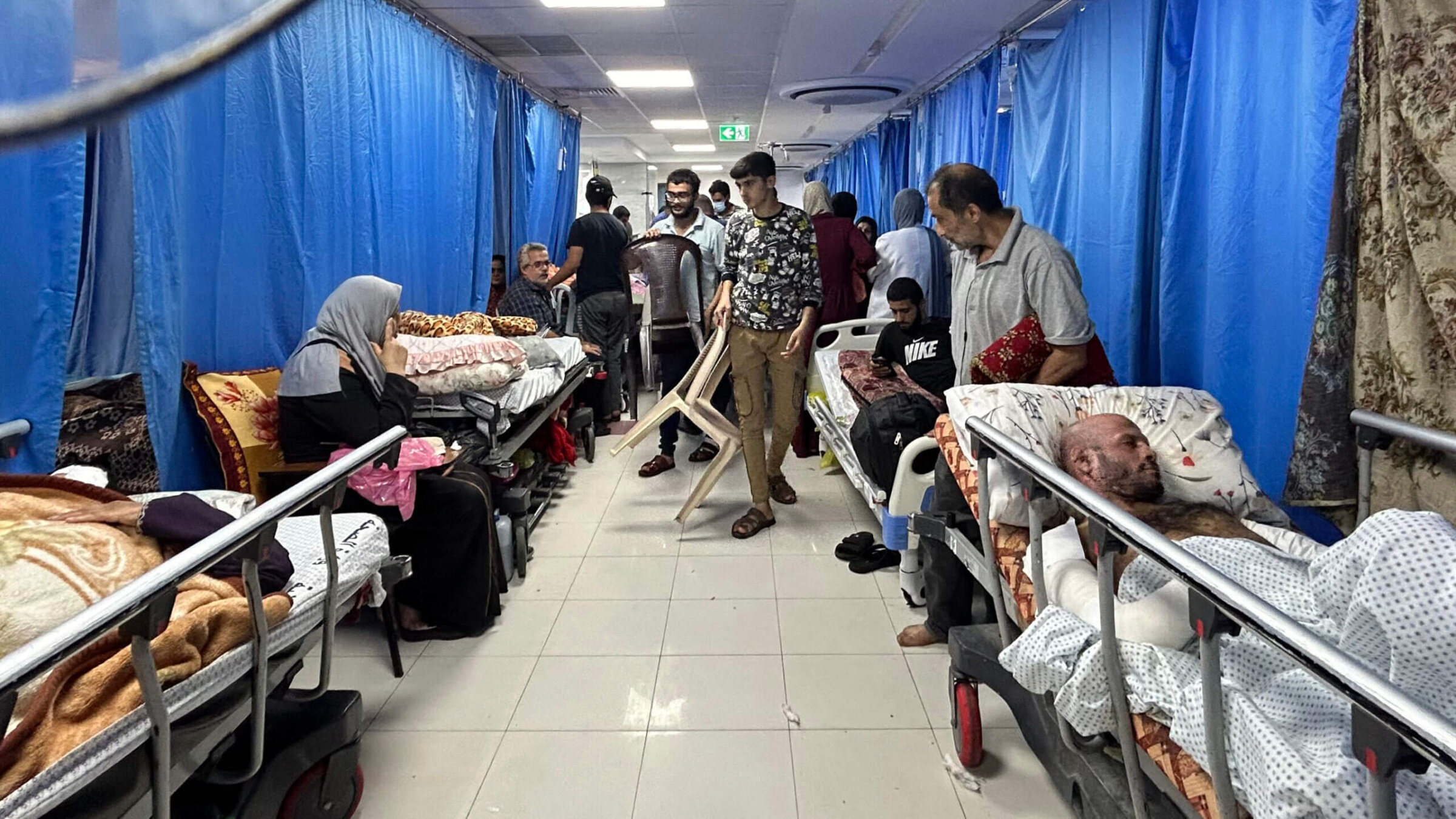
Patients and internally displaced people al-Shifa hospital in Gaza City last week. Photo by AFP
As Israeli soldiers entered Gaza’s al-Shifa Hospital this week, the world’s attention was on whether they’d find the long-rumored Hamas bunkers under its wards. But I’m yearning to see something else: Israelis rescuing and treating Shifa’s desperate Palestinian patients.
I want to watch the Israel Defense Forces bring in the fuel required to power the generators to turn the incubators back on in the neonatal unit and get dialysis machines and ventilators pumping again. To see military medics resupply operating rooms and save the lives of civilian war wounded. Why not pass out IDF rations to the hundreds of families sheltering on the hospital’s lawn?
If running a hospital in an active war zone in enemy territory is too risky, Israel could evacuate the most severely injured to its own vaunted hospitals. Or set up a field hospital on the other side of the broken border fence with Gaza, as it once did for Syrian refugees, no friends of the Jewish state.
During the so-called “stabbing intifada” of 2015, Israeli emergency rooms proudly treated both the Jewish victims of terror attacks in Jerusalem and their Palestinian perpetrators. Now the IDF has the opportunity to help address the inevitable collateral damage of its campaign to rout Hamas from Gaza and rescue the 200-plus hostages abducted on Oct. 7.
This would be good PR, and perhaps provide Israel a little leeway from allies increasingly outraged by the devastating death toll and seemingly indiscriminate bombing in Gaza.
It would also be the humanitarian thing to do. Which is to say, the Jewish thing.
I first visited Shifa, the largest of Gaza’s six public hospitals, in September 2012. I was doing a story about the deep poverty gripping the 139-square-mile Palestinian coastal enclave after a United Nations report suggested that it might not be a “livable place” by 2020.
An 18-year-old “who could not find work beyond peddling potato chips,” as I wrote then in The New York Times, had recently self-immolated on the hospital lawn. Inside Shifa, I saw intubation kits a year beyond their expiration date and empty supply cabinets: They were short of antibiotics, anticoagulants, even plastic gloves and baby formula. There were 750 beds, and 2,000 sick people a day.
“The only thing available enough here is patients,” a surgeon told me.
And that was between wars.
Two months later I was back at Shifa, this time with the sounds of Israeli drones and Hamas rocket fire nearby. We reporters seemed to end up at the hospital nearly every afternoon during the eight-day war that Israel dubbed Operation Pillar of Defense. To follow the victims of a particular airstrike. To talk to those taking refuge on the grounds because their neighborhoods were bombed out. To attend news conferences by the Hamas leaders who run Gaza.
Yes, the rumors of Hamas storing weapons and operating command centers underneath the sprawling hospital complex were rampant back then, too, though Israeli soldiers were not on the ground in Gaza during the 2012 war to try to prove it.
Yes, we saw Hamas militants with their trademark green scarves and headbands and even some commanders hovering in the hospital, lending credence to Israel’s accusation that the group exploited its patients and employees as human shields, a war crime.
And yes, the doctors and nurses I met at Shifa were dedicated public servants heroically trying to do their jobs in dire circumstances.
Did they resent or even despise Israel, for its relentless attacks and ongoing restrictions on travel and trade into Gaza? Yes. Did they want to wipe it off the map? Perhaps. Did they yearn to murder Jews like me? No.
Nor did they, or their patients, revere Hamas.
“We are not Hamas, and we are not with the others,” said a 34-year-old woman camped on Shifa’s lawn with her 6-month-old in a car seat. “We just want to live in our homes.”
One day we toured Shifa’s wards with Ismail Haniyeh, the Hamas prime minister, and his Egyptian counterpart, Hesham Qandil. Haniyeh held the body of a baby slain in the war, and talked to the father of a 2-year-old whose skull had been fractured by debris from shelling near the border. “What was his fault? What was his guilt?” the man cried.
Another afternoon at the hospital, a large screen flashed images of the wounded as a boy hawked coffee and tea from a kettle and thermos, a shekel a cup, to the crowd awaiting a delegation of Arab foreign ministers. As I took notes on the surreal scene, a makeshift market outside an overcrowded hospital during a war, the fleeting calm was shattered, first by the sound of militants nearby firing a rocket toward Jerusalem, and then by a series of explosions in the distance — Israel’s telltale response
Next: Sirens. Six ambulances streamed into Shifa’s circular driveway, unloading the bodies of men the Hamas officials on hand identified as fighters, at least two of them without heads. Then three more, carrying dead and wounded kids.
“There’s a real massacre now,” said the Hamas spokesman who had been awaiting the diplomats. The Gaza health ministry, run by Hamas, at that point put the Palestinian death toll at 130. It would be more than 10 times that by the war’s end, according to after-action reports by independent human rights groups and the U.N. That seemed staggering at the time, and now feels like something of a skirmish.
The crowd at Shifa that day chanted, “Revenge, revenge, Qassam Brigades, get revenge for us,” referring to Hamas’s military wing. None of us there — not the chanters, not the visiting diplomats, not we journalists — ever imagined the scope, scale or barbarism of the revenge to come for Israel nearly 11 years later, on Oct. 7, 2023.
After entering Shifa this past Wednesday, the Israeli military shared photographs of some weapons it said it found inside — evidence, it said, of Hamas operating from the hospital. Hamas and some Palestinian advocates scoffed at the photos, saying they were fabricated, or that such a small cache proved little. The propaganda wars continued to rage across social media.
On Thursday night, the IDF escorted journalists from The Times into Shifa, and showed them a stone-and-concrete shaft they’d uncovered under a pile of sand near the northern perimeter of the hospital complex. There was a metal staircase descending into the earth that the military suspects leads to a Hamas military facility underground. But they said they have not gone in, for fear of booby traps.
“This is not a hospital you know, it was commandeered by Hamas,” Prime Minister Benjamin Netanyahu said of Shifa during an interview on NPR’s Morning Edition Friday. “It’s a military compound. This is a commandeered hospital. It’s not Mount Sinai.”
Netanyahu said that as the troops entered, they brought “Arabic-speaking doctors” and “incubators for babies.” The IDF had told journalists the same thing when soldiers first entered Shifa on Wednesday and earlier brought in fuel.
I am hoping for much more.
Expert analysis of whether the weapons found at Shifa justified the Israeli attacks, according to the international laws regarding proportionality of civilian collateral damage, will have to wait for the fog of war to clear. The patients inside the hospital’s wards are at risk of dying now, along with the starving displaced outside its doors.
The IDF has an opportunity to fulfill its oft-stated aspiration of being the world’s most moral army. To follow the Jewish commandment of pikuach nefesh, to place the saving of a life above all else, because as the Talmudic saying goes, to save a life is to save a world. Because, in this awful war, we have to keep choosing the side of humanity.
The next pictures I want to see from Shifa are not whatever is at the bottom of that metal staircase. I want the hospital up and running again, perhaps with Israeli medics working side by side with Shifa’s own devoted medical staff to treat the wounds and save the lives of all the people in the path of this war.
What I’d like to see at Gaza’s al-Shifa Hospital is not proof of Hamas operations but of the IDF’s Jewish values.
A message from our Publisher & CEO Rachel Fishman Feddersen

I hope you appreciated this article. Before you go, I’d like to ask you to please support the Forward’s award-winning, nonprofit journalism so that we can be prepared for whatever news 2025 brings.
At a time when other newsrooms are closing or cutting back, the Forward has removed its paywall and invested additional resources to report on the ground from Israel and around the U.S. on the impact of the war, rising antisemitism and polarized discourse.
Readers like you make it all possible. Support our work by becoming a Forward Member and connect with our journalism and your community.
— Rachel Fishman Feddersen, Publisher and CEO



